There are various of types of shower valves available, including a range of features and benefits. All these types fulfil the same purpose, but different features make them appropriate for different circumstances.
The main purpose of these shower valves is to control the water pressure and temperature and helps you to enjoy your dream shower. Because of the different shower valves varieties, choosing the right one is confusing.
This guide has discussed some common types of shower valves along with their features and benefits. After reading this guide, you can choose the best shower valve for your bathroom.
What Is a Shower Valve?
Shower valves are the metallic parts of your shower fixture and are hidden behind the trim in the wall. Although you can’t see these fittings when you enter a tub or shower, they are significant because they regulate hot and cold water from the shower head.
The valve is frequently to blame when something goes wrong with a shower or bath fixture or any water flow or temperature control issue.
Therefore, before starting any renovating tasks, it’s beneficial to comprehend the fundamental distinctions between the most popular types of shower valves and how each one differs.
Types of Shower Valves
- Manual Shower Valve
- Digital Shower Valves
- Diverter Shower Valve
- Shower Mixing Valve
- Thermostatic Shower Valves
- Transfer Valve
- Pressure-Balancing Valves
1- Manual Shower Valve
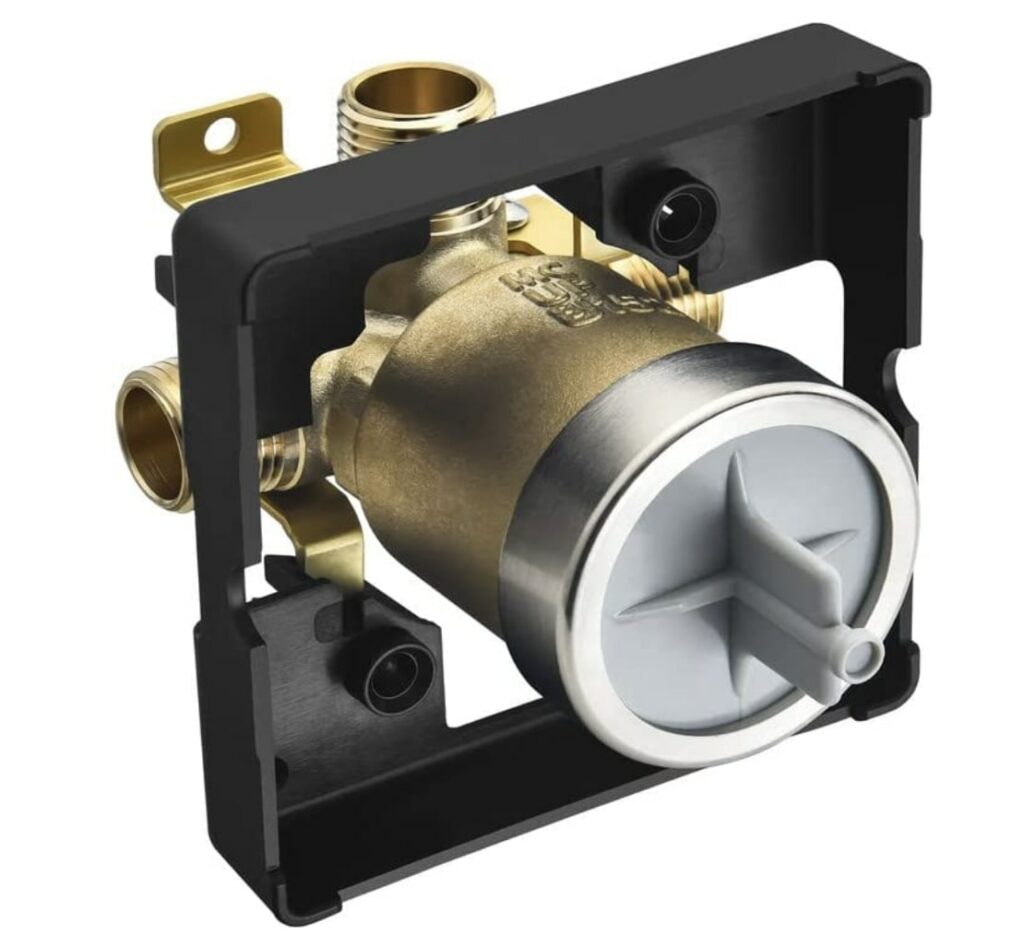
This shower valve has a single handle that can regulate the water’s temperature, pressure, and on/off functionality.
The primary benefit of manual shower valves is that they are highly affordable. This type of shower valve is acceptable if you won’t use it on young children or if you are remodeling your bathroom on a limited budget.
The main issue with this kind of shower valve is that it does not maintain and regulate the water temperature, mainly when used in a home where children or older people reside.
Therefore, the water in the shower may become extremely hot or freezing if a tap in your home is switched on or when the toilet is flushed.
2- Digital Shower Valves
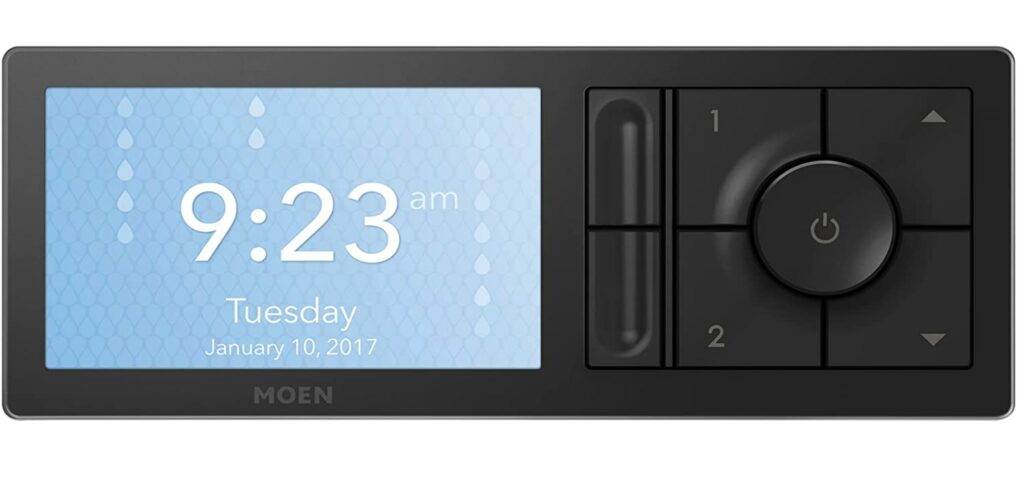
The easiest way to operate your shower is with a digital shower valve, which is quickly gaining popularity. By pressing a button, these valves can set the water temperature.
They can also pair with Bluetooth-enabled devices to operate the shower from afar. This includes turning it on and off, adjusting the water pressure and temperature, and even managing extra features like LED lighting.
The primary benefit of these shower valves over manual is that you can fine-tune the temperature and set it at an exact temperature instead of estimating the temperature based on how hot it feels. Additionally, you can turn on the shower remotely without getting soaked.
3- Diverter Shower Valve
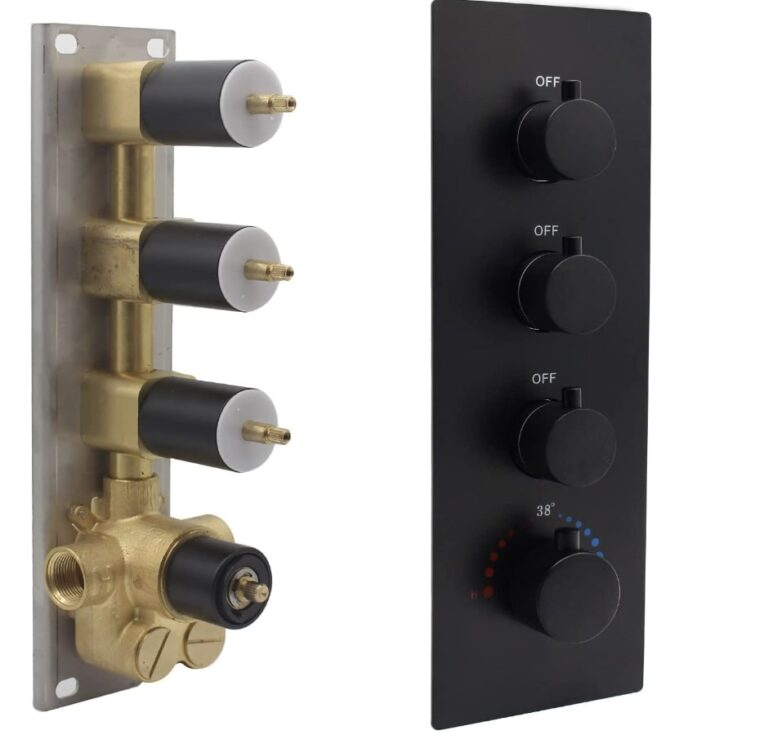
Diverter shower valves are precise, functional devices. Depending on how many outlets are active, this aesthetically appealing valve operates as intuitively as you want.
Diverter shower valves allow you to divide the water flow between multiple shower heads. Therefore, you can forego using a shower faucet with a diverter if you only intend to use one shower head.
Water can be transferred from a bathtub spigot to a showerhead, another sprayer, or both using a shower diverter valve (DV). Even though they are frequently found in tub-shower combinations, these are optional if you only have one showerhead.
4- Shower Mixing Valve
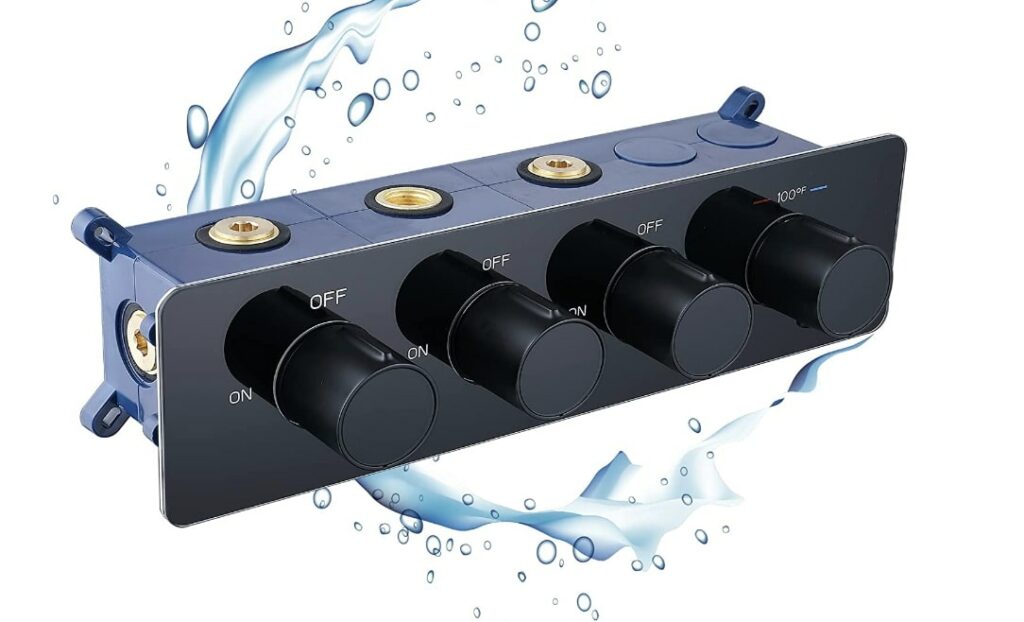
Mixing valves draw water from both the hot and cold taps and combine them to create a temperature balance. They are typically found in older houses.
You probably have mixing valves in your bathroom, which need to be made to handle sudden changes in temperature from hot or cold water sources if you’ve ever experienced a burst of hot water after someone flushes the toilet.
Mixing valves were among the least expensive shower valve varieties available, making them ideal for people building a home on a limited budget.
5- Thermostatic Shower Valves
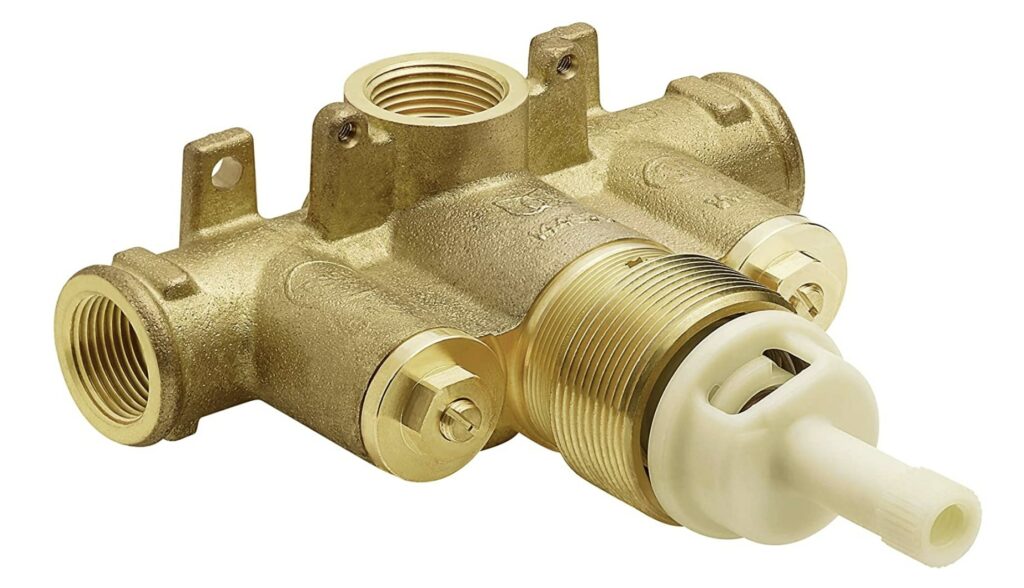
A thermostatic valve ensures that the shower’s water temperature is maintained. Once you have chosen a temperature setting when you turn on the shower, It won’t surprise you by getting hotter or colder suddenly during the length of the shower;
These shower valves usually have two handles; one is used to turn the on and off the water and may also be used to control the water’s volume, while the other handle regulates the temperature of the water.
These valves have the advantage that once you’ve settled on a temperature you like, you can keep the handle in that spot and only use the on and off handles to get in and out of the shower. This will eliminate the need to repeatedly find the ideal shower temperature, saving time and aggravation.
6- Transfer Valve
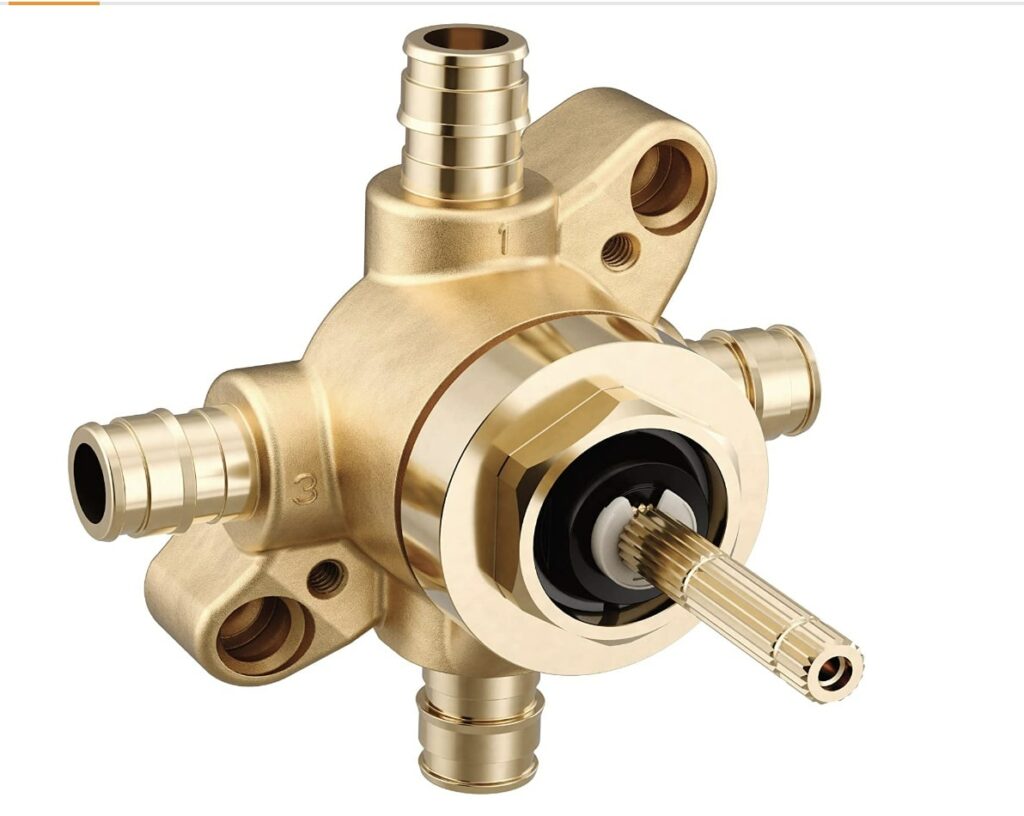
Transfer valves enable water flow to be sent to numerous outlets simultaneously, as opposed to diverters, which switch the water flow between a tub and a shower.
These systems are perfect for operating a handheld showerhead without turning off the main shower or running shower walls.
While most transfer valves only let you use one or two components at once, some valves let you use more than two. In these valves, the setting will engage one or a combination of two components simultaneously but cannot run all three at a time.
7- Pressure-Balancing Valves

These valves, also known as mechanical valves, use the difference in pressure brought on by abrupt temperature changes. The system maintains the water at the desired temperature once you have turned on the water and set the temperature as you prefer.
It should be highlighted that this valve controls the amount of pressure, not temperature. Consequently, when water is diverted to other appliances, the water flow from your shower head may change.
Additionally, when remodelling an older house, pressure balancing valves may only sometimes be a good option because pipe corrosion may reduce the valve’s effectiveness.
Types of Shower Valves Configuration
Although there are various shower valve configurations, I have simplified them into three categories.
- One Way –Twin Shower Valves
- Two Way – Twin Shower Valves
- Three Way – Triple Shower Valves
1- One Way –Twin Shower Valves
As the name implies, twin shower valves have two controls. Twin shower valves that open only one direction can only provide one shower function, not two.
For instance, a small shower on a slide bar or an overhead shower, but not both. The two controls regulate the passage of water and its temperature.
2- Two-Way – Twin Shower Valves
Twin shower valves have two settings. Two-way conjunction shower valves can supply two shower functions, but not simultaneously. This indicates that you can swap from one outlet to another.
The temperature control on two-way twin shower faucets is identical to that on one-way twin shower valves.
Rather than the flow control, the diversion distinguishes the two-way twin shower valve from the one-way twin shower valve. Its main purpose is the diverter’s ability to move between the shower outlets.
The diverter’s only disadvantage is that it cannot regulate the water flow’s rate as effectively as a flow control.
3- Three Way – Triple Shower Valves
The triple shower valve’s three-way name signifies it can provide three shower outlets.
Two-way diverter and flow control are the valve’s additional two settings. The two-way diverter controls the water flow between one of the two outputs; alternatively, the water flow can be stopped by activating the diverter.
The flow control feature aims to regulate the water flow from a third outlet’s full-off position to full-on.
You can see that the three-way triple shower faucet has a somewhat intricate design. Large showerheads like ceiling drenchers and detachable handheld showers frequently use these shower valves.
FAQs
What is the best type of shower valve for you?
Your requirements and preferences will determine which sort of shower valve is best for you. A multipurpose shower valve might be the best choice if you want a simple valve to install. u003cbru003eu003cbru003eA thermostatic shower faucet might be your best bet if you want fine control over the water’s temperature. A flow-control shower valve may be your best bet if you have poor water pressure.
How to make your valve last long?
Reputable manufacturers design their shower valves to last a very long period. Shower frequently to maintain them in top condition. A shower that is used frequently will deteriorate more slowly than one that is rarely used.u003cbru003eu003cbru003eInstalling a water conditioner when remodelling or replacing your water heater will extend the life of your shower valves by softening the water that travels through them, preventing scale and hard water buildup.
Conclusion
Shower valves come in different varieties, each with unique methods for making showering more practical.
In the article, we have mentioned different types of shower valves to help you make a wise professional decision. If you’re having difficulty choosing the best shower valve, evaluate the available ones.

